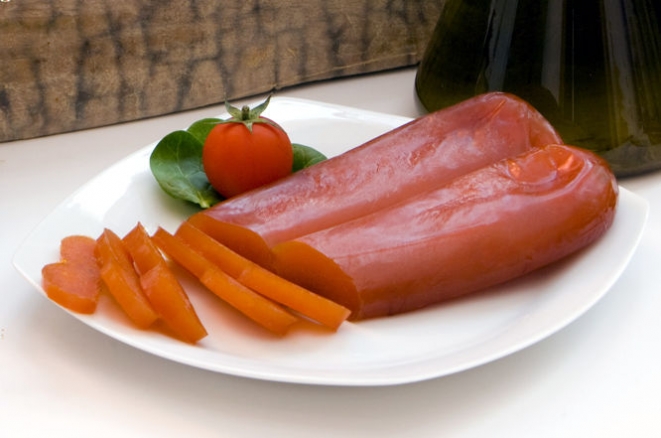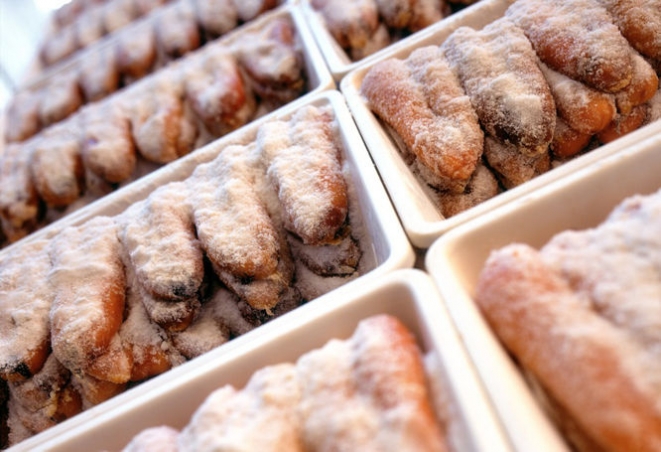The Sardinian bottarga
The simple dish most delicious than caviar
Mediterranean caviar, gold of Sardinia, sea-smell dust amber, strong flavor, slightly bitter, brackish, it does not allow for half measures. You love it or you hate it.
Eaten as a starter or, in the tradition of Cagliari, as a spaghetti sauce, is rich in Omega 3 and protein and it also contains squalene, steroid useful, it seems, to nourish the skin, relieve joint inflammation and to strengthen the muscles.
This is the bottarga, a delicacy food Sardinian coming by the thousands of eggs produced by the mullet roe, salted and dried by traditional methods.
The best known kinds of bottarga are the mullet and tuna ones. Either kinds are found in commerce both in egg sacks, whole pieces constituted by the undamaged ovarian sacs, similar to an amber ham, and in powder, less expensive but of lower quality.

The production of bottarga is especially Sardinian. The main production centers are the Gulf of Cagliari, the Ogliastra (Tortolì), Sarrabus, Sant'Antioco and the Oristano area (Marceddì, Terralba and the Pond of Cabras).
It is especially Oristano that offers a superior product: the Pond of Cabras in which abounds mullets, ovarian sacs are processed immediately after fishing and salted using traditional methods.
Every year in mid-August, Cabras is theater of the Festival of bottarga, during which you can taste local typicality as an ingredient in various dishes and combined with other products.
However, the main area of production of red tuna bottarga is Carloforte. Alghero also produces bottarga of ling, fish similar to the hake, but with a less deeper taste.

The bottarga, in the Sardinian language butàrga or buttariga, is part of the history of Sardinia. It was imported about three thousand years ago by the Phoenicians, then widespread in the Mediterranean by the Arabs who renamed it butarih (salting). It became over time a fine dish, enough to be used as a royal gift.
Its origins date back to five thousand years ago, at the Egyptian civilization: the Nile was full of mullets and their eggs, extracted during the cleaning, were salted, balled up, pressed, getting in this way an ancestor of the bottarga.
It seems there are found traces even inside some pyramids that kept the eggs of mullet in ozokerite, a mineral wax.
In origin, the bottarga was part of the traditional meal of the Sardinian fishermen who spent the whole day at sea. They extracted, without breaking, the ovary sac (gonad) from the female fish, and after having cleaned, salted and pressed they aged for a few months. The procedure, over time, has not changed.
The Sardinians have refined the techniques in a millennial processing that has been passed down unchanged from generation to generation. Modern technologies have not altered the old process.
Each couple of ovarian sacs is processed individually, and the whole production process is done manually, and the ISO 9001 certification ensures compliance with the rules.
Between late summer and early autumn the fishermen go looking for female mullets, the fatter with the adipose eyelid, and they slice the abdomen to extract the ovaries full of eggs.
This phase is very delicate: if the film enclosing the eggs were broken or damaged, would no longer be possible to process them.
After extraction, the eggs are washed with water and ice and cleaned of any residue. In the second phase, the salting, the egg sacks are salted and left that way for a little while.
In the third step, the egg sacks are washed one by one, pressed and laid for drying, then hung to allow a natural drying for five days, and finally left in a dark for two or three days, to take on the typical scent.
Thanks to new fishing techniques to some courageous companies, bottarga is now exported all over the world. Recently it has been asked for a protected designation of origin to limit imitations and counterfeits that affect the quality.
The most valuable mullet bottarga is the one sold with "su biddiu" (the navel), a part of the gutted fish with the gonad. The mullet is the only species with a wrapped eggs very resistant to press and rub with salt and the Sardinian product, by an incomparable taste, is the only one worthy to compete with caviar.
The mullet is a fish that likes the sewage, so to have a mullet of good quality is essential that the fish come from an environment free from pollution: this explains the strong demand for the bottarga obtained from eggs caught in Sardinia.
From simple dish, poor, reserved for fishermen away from the mainland, a delicacy for connoisseurs and gourmets, the bottarga, an increasingly important role in haute cuisine, is part of the PAT (Foodstuffs) Sardinian recognized by the Minister of Agriculture, Food and Forestry and is now living his time of glory: a year ago, the foreign press has devoted mullet bottarga better than caviar.
An article in Los Angeles Times, signed by Irene Virbila, conquered by the Sardinian bottarga, describes it as "a brackish treat of Mediterranean that is worth trying [...]. Every time I go to Italy I make a stock. Ten years ago it was difficult to find but now it is its time."
Sophisticated and versatile, it is delicious thinly sliced, with a drizzle of extra virgin olive oil, a dash of lemon and a sliced tomato, but also blends with fresh vegetables and grated on first courses, especially spaghetti or rice dishes. It goes well with a Vernaccia of Oristano or a Vermentino wine.